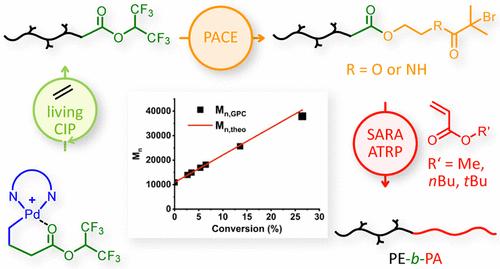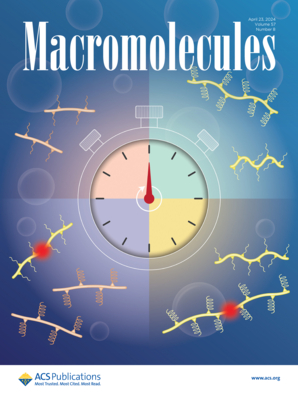Polyethylene-poly(methyl acrylate) Block Copolymers from PACE-SARA ATRP: Utilizing Polyolefin Active Ester Exchange-Based Macroinitiators in Atom Transfer Radical Polymerization
IF 5.1
1区 化学
Q1 POLYMER SCIENCE
引用次数: 0
Abstract
Accessing a facile pathway to prepare polyolefin-polar block copolymers with low dispersity and high control remains a challenge due to the distinct polymerization pathways of the composing blocks. This study utilized the polyolefin active ester exchange, the PACE approach, as a viable solution. The PACE approach, using palladium-catalyst-based coordination-insertion polymerization, was combined with SARA ATRP (supplemental activator/reducing agent atom transfer radical polymerization). A single-chain-end active ester functionalized polyethylene (PE) was produced from an α-diimine Pd(II) hexafluoroisopropyl ester chelate complex, which facilitated a living polymerization of ethylene. Transesterification with 2-hydroxyethyl α-bromoisobutyrate (HOBIB) or 2-hydroxyethyl α-bromoisobutyramide (HOBIBA) formed α-bromoisobutyrate or α-bromoisobutyramide chain-end-functionalized polyethylene. The approach resulted in controlled synthesis of polymers with low dispersity (Đ), high initiation efficiency, and high reproducibility. Both the amide-linked and ester-linked macroinitiators showed >90% initiation efficiency and Đ values of block copolymers as low as 1.05. This work demonstrated a successful combination of two living polymerization techniques, an insertion and controlled radical polymerization, unified in PACE-SARA ATRP, offering access to polyolefin-containing block copolymers with chemically distinct structures.

求助全文
约1分钟内获得全文
求助全文
来源期刊

Macromolecules
工程技术-高分子科学
CiteScore
9.30
自引率
16.40%
发文量
942
审稿时长
2 months
期刊介绍:
Macromolecules publishes original, fundamental, and impactful research on all aspects of polymer science. Topics of interest include synthesis (e.g., controlled polymerizations, polymerization catalysis, post polymerization modification, new monomer structures and polymer architectures, and polymerization mechanisms/kinetics analysis); phase behavior, thermodynamics, dynamic, and ordering/disordering phenomena (e.g., self-assembly, gelation, crystallization, solution/melt/solid-state characteristics); structure and properties (e.g., mechanical and rheological properties, surface/interfacial characteristics, electronic and transport properties); new state of the art characterization (e.g., spectroscopy, scattering, microscopy, rheology), simulation (e.g., Monte Carlo, molecular dynamics, multi-scale/coarse-grained modeling), and theoretical methods. Renewable/sustainable polymers, polymer networks, responsive polymers, electro-, magneto- and opto-active macromolecules, inorganic polymers, charge-transporting polymers (ion-containing, semiconducting, and conducting), nanostructured polymers, and polymer composites are also of interest. Typical papers published in Macromolecules showcase important and innovative concepts, experimental methods/observations, and theoretical/computational approaches that demonstrate a fundamental advance in the understanding of polymers.
 求助内容:
求助内容: 应助结果提醒方式:
应助结果提醒方式:


